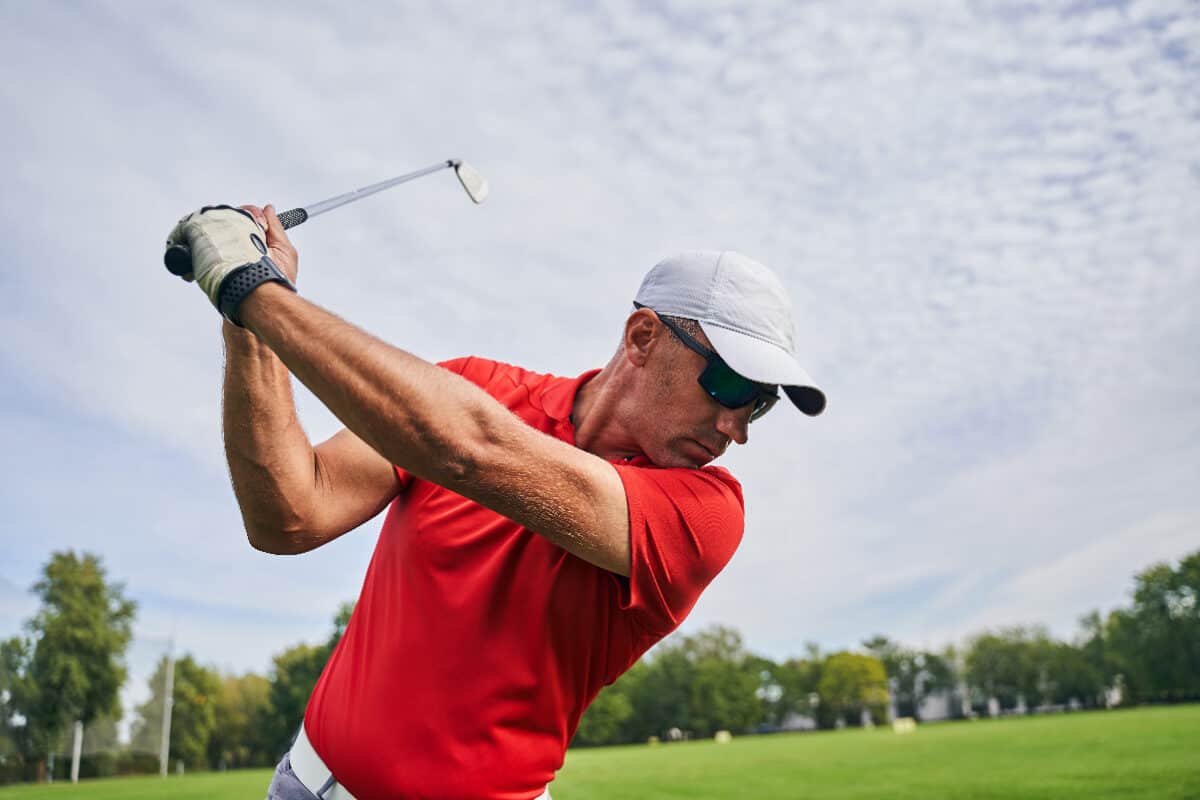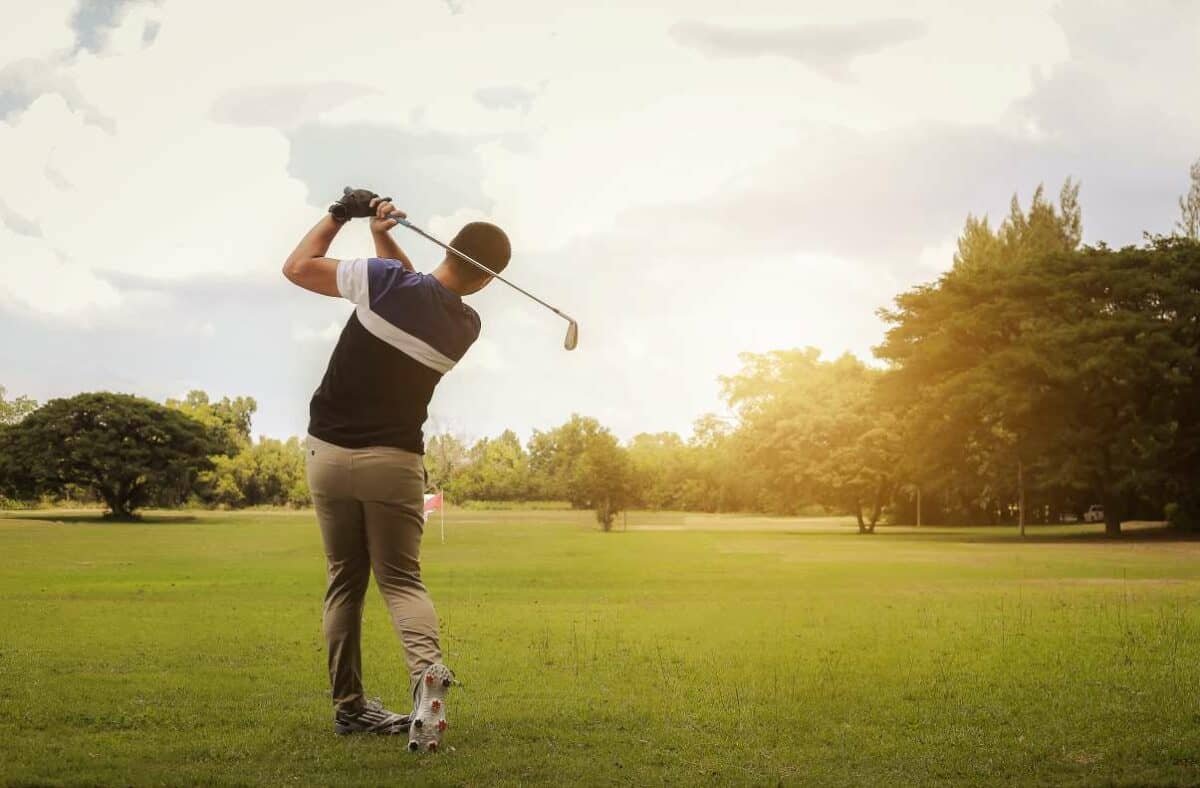How to Turn Through the Golf Ball for Crisp Ball Striking?
Making solid contact with the golf ball requires more than just swinging hard. You need to understand body sequences and turn dynamics for central-face hits. One of the keys is learning how to properly turn through the ball.
Turning your body fully through impact begins the downswing and accelerates into a balanced finish.
When performed correctly, it promotes compressed strikes for peak distance and accuracy.
Read on for a full breakdown of what it means to turn through the golf ball along with drills to groove this essential move.

What Does Turning Through the Ball Mean?
Turning through the ball refers to maintaining your shoulder and hip rotation coming down into and just after the ball impact. This sequential motion keeps your body and club moving fully left (for righties) during the downswing.
Too often, golfers stop their lateral motion prematurely on the downswing. Their upper body stalls out while their hands and arms continue swinging. This disconnection causes all kinds of ball-striking problems.
Turning through maintains upper and lower body synchronicity. Your shoulders pull your hands and clubhead through the hitting zone for solid compression.
Why Turning Through Matters
Letting your upper body slow down or stop turning during the downswing is incredibly destructive for clean ball striking. Here is what goes wrong:
- Your clubface rotation gets faster than body rotation. This leads to inconsistent delivery.
- Lack of supportive shoulder motion decreases clubhead speed.
- The strike location on the face becomes erratic and the gear effect magnifies misses.
- The ball contact point moves higher on the face leading to thin shots.
- Reduced compression into the back of the ball causes power loss and poor launch.
- Spin rates destabilize without a square impact. Curve and distance control fade.
Conversely, fully turning through stabilizes the clubface, optimizes compression, and produces powerful draws when executed properly.
How to Turn Through the Ball
Follow this step-by-step process on the downswing to turn through correctly:
- Start your downswing by firing your hips to begin uncoiling while keeping your upper body steady.
- As your hips unwind, let your trailing shoulder pull your hands and club down into the slot.
- Maintain hip and shoulder rotation with the upper body chasing the hips down toward impact.
- Move your sternum directly over the ball as you compress with a slight downward strike.
- Keep turning your shoulders past impact without overly sliding or swaying. Feel like your belt buckle points at the target.
- Finish in a fully turned position with hips cleared and weight on the lead side.
Practice turning through with smooth, powerful acceleration. Eliminate any abrupt motions that impede body-club synchronicity.
Drills for Improving Your Turn
Incorporate these great drills to reinforce sound mechanics for turning through the golf ball:
Wall Turns – Make backswings into a wall to feel the proper shoulder turn and hip bend. Rehearse the same separation going forward with resistance.
Alignment Stick Sequence – Place sticks on the ground indicating where hips and shoulders should be at different spots in the swing sequence. Turn through each stick.
Lead Leg Drive – Make downswings focusing on driving the lead knee towards the target to activate the lower body turn. Feel like you are squeezing a ball between your knees.
Resistance Bands – Attach resistance bands around your trail hip and lead shoulder during practice swings. Fight the tension while turning to build strength.
Mirror Check – Set up in front of a mirror and match positions from address to impact seeing your hips uncoil and upper body chase.
Split Turns – Separate upper and lower body motion. First, just turn your shoulders, then just turn your hips to dial in the proper sequence.

Common Turning-Through Errors
Watch out for these common mistakes golfers make related to the downswing turn:
Stalling the Upper Body
Letting the upper body lag or stall comes from starting a downswing with just hands and arms. Hips and shoulders must initiate together.
Overly Sliding Hips
Excessive lateral slide rather than true turn delays hip-shoulder separation. Maintain some flex and coil while clearing left.
Spinning Out
Spinning the hips too early casts the club outside the ideal plane. Turn should unwind not spin open for solid contact.
Downward Chopping
Chopping with stiff arms declines the shoulder plane too early. Keep turning horizontally before dropping into impact.
Disconnected Arms
If arms and clubs get stuck behind body rotation, you’ll never reconnect them for square contact. Keep elbows rotating down.
Drills to Stop Turning Errors
Here are some drills to eliminate downswing turn errors:
Feel the Sequence – Make rehearsal swings dramatically pausing between hip bump and shoulder turn to learn proper timing.
No Hands Full Swing – Take smooth full swings holding the club just in your fingers without grip pressure to get the body leading properly.
Align Chest and Belt – Check positions at address with the chest and belt buckle aligned. Maintain that orientation through impact.
Wall Tap – Tap shoulders into a wall on takeaway then tap the belt into the wall on the downswing to stay connected.
Flare Turns – Feels awkward but makes half swings where lead shoulder initiates downswing to fix getting stuck issues.
Split Grip – Remove the dominant hand completely from the club on the downswing to eliminate overly fast hands and arms.
Learning to coordinate your upper and lower body into a synchronized downswing turn eliminates most of the bad ball striking.
Benefits of Proper Turning
Mastering the full turning motion provides powerful improvements:
- Optimized clubhead speed and transfer of body power into the ball
- Consistent, crisp ball contact across the face
- Maximized backspin and shot-shaping ability
- Penetrating ball flight that pierces through the wind
- Ability to compress shots cleanly from all lies and conditions
- Balance, speed, and strength with reduced injury risk
Turn through the ball confidently for your best shots yet!
Conclusion
Turning fully through impact initiates an efficient downswing sequence and unifies your body motion to strike shots purely.
Stalling or disconnecting the upper body leads to gear effect inconsistency and diminished power. Keep your hips and shoulders rotating together by letting your trailing side pull the club down into a centered strike.
Groove the proper positional sequence with drills. Learn to harness your body’s momentum by turning through the ball for true compression and control.


